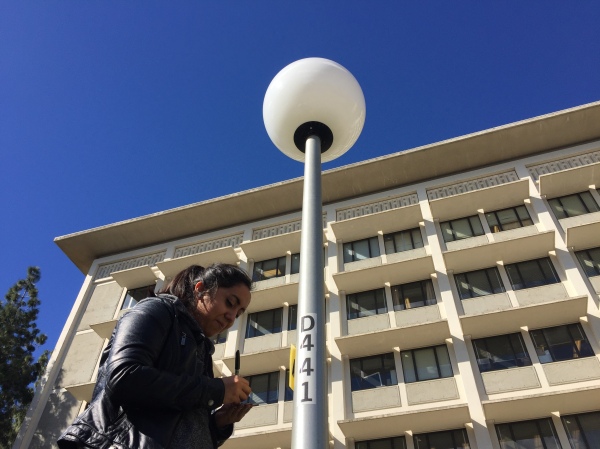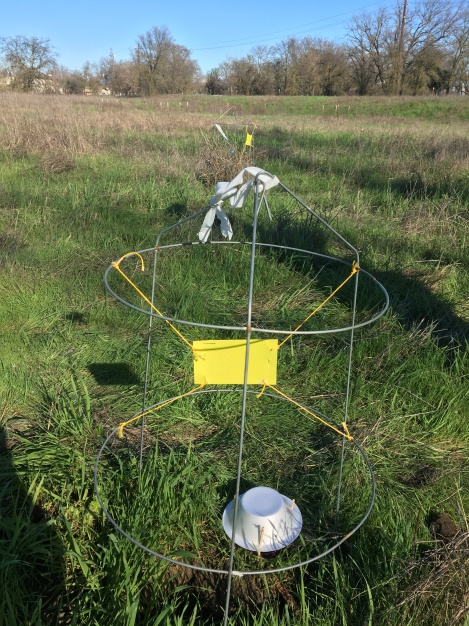These last seven weeks have provided me with a really new experience. After thorough research, deliberation, and contemplation, we have finally decided on a specific study system. As a class, we have decided to ask how artificial light affects spider communities. What are the next steps? It was hard enough deciding on a specific question in a specific study system, but how do we begin to synthesize a more ecologically innovative and testable question?
We started class with a super productive roundtable discussion. We asked each member of the class to explain what really interested them about spiders and artificial light. What do you find interesting about this question, and where would you like to see the question go from here?
There was a broad interest about how artificial light will effect the trophic interactions of spider predators and plants. Last class, we discussed the possibility of placing artificial lights near plants. We expect light to attract flying insects. We also expect this light to attract spiders. Are there any resulting consequences for these plants near light? Will increased spider density benefit the plant through increased predation on herbivorous insects? Will increased spider density harm the plant through increased predation on potential pollinators? Ultimately, does light and spider abundance have an effect on plant fitness? Also, artificial light could attract other predatory arthropods. How would these carnivores play into this food web?
There was also a broad interest in the behavior of spiders in response to light. Many spiders are considered strictly nocturnal or diurnal. How plastic is this behavior? How plastic is nocturnally and diurnally? Would nocturnal spiders become active during the night if presented with artificial light? More specifically, how have different spider populations evolved in response to artificial light? Will urban spider populations have a greater preference for well lit sites compared to non-urban spider populations? Can we test this?
It might also be interesting to study competition among spiders around a light source. Will spiders saturate a lit area to the extent that some capture more prey items than others? Would larger spiders be competitively dominant over smaller spiders near a light source?
After this productive discussion, we managed to boil our interests down to three broad questions.
- How does artificial light affect arthropods?
- How does artificial light affect plants?
- How has artificial light affected the evolution of different spider populations?
I find myself asking again, now what? How do we take this a step further? We play around in the field! For the rest of class, we put our efforts in the field. Our goal was to do some field sampling of spiders and other insects. We split up into three groups: team sticky traps, team light and tomato cages, and team pitfall traps.
On campus, we set up sticky traps on light posts. Hopefully they’ll stay over the weekend, and we can find some cool urban insects!

In more rural areas, we traveled to the 180 field.
On a slight side note, we plan to collect the majority of our experimental data at the Experimental Field, which is part of the Putah Creek Riparian Reserve. This site is closed to the public and requires that we submit a research request before collecting any data. Asia (awesomely) completed the form and sent it, but we are still waiting for approval. For this reason, we went to an alternative field site to collect some preliminary data.
At the 180 field, we set up 16 tomato cages. We dispersed the cages evenly in open grassland and around more structured plants and shrubs. Each tomato cage contained a cleverly placed sticky trap and a pitfall trap. We placed pitfall traps inside tomato cages, and used an ethanol-water solution to preserve insects.
We only had two lights (one solar powered and one bike light). We chose to light one tomato cage in the open grassland and one tomato cage in a more densely vegetated area. Each lit cage was near an unlit cage, so that we can compare insect collections in lit and unlit areas. Maybe we’ll collect different groups of insects in those the lit areas? We will soon find out!
The field team diligently completed tasks. One group created hangable sticky traps using yarn, a knife, and sticky cards.
Another team created pitfall traps with perfectly sized plastic cups. They even created styrofoam rain shields over each sticky trap. So much rain!
They even created styrofoam rain shields over each sticky trap. So much rain!
The end result was rather aesthetically pleasing (first claimed by Cameron). 
We ended our field adventures by collecting some orb weavers. We brought them back to the lab, and Robert and John made them nice little homes (homes not pictured).

Overall, it was a beautiful day for some fieldwork.
This class is so cool!!!!
For Tuesday:
(1:40 – 2:00) Think of questions for Eric Lopresti!!!
(2:00 – 2:30?) Talk with Eric.
(2:30 – 3:00) Sort through pitfall traps. If possible, identify spiders and determine if there was a difference between open grassland, shrub, and light pitfall traps. Also, collect campus sticky cards.
(3:00 – 4:00) Class discussion. What specific questions should we continue pursuing? Talk about experimental design.
(4:00 – 4:15) Create teams. We need an engineering team to figure out lighting. We can discuss specific tasks and create teams.
(4:15 – 4:30) Plans for next class. Hand it over to the blogger.
*Questionable: Is Eric Lopresti coming to class for a talk?
Great blog, but could we get an clear agenda/schedule for Tuesday? Might be good to leave some time there for continuing to work on questions and hypotheses.
Gotchya!